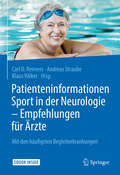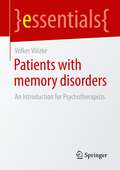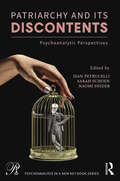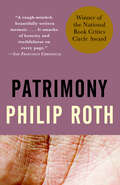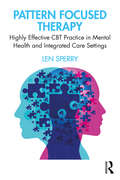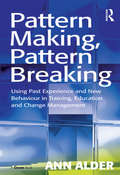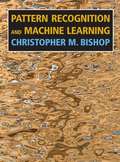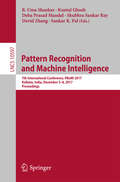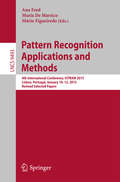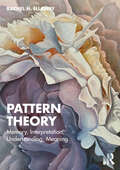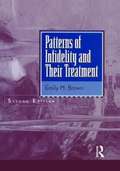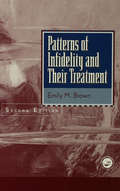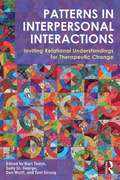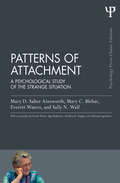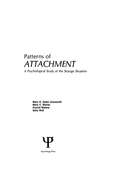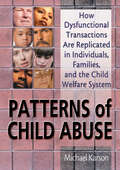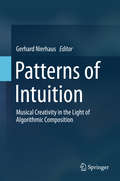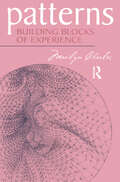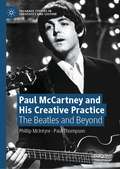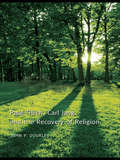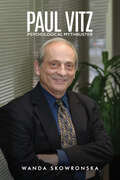- Table View
- List View
Patienteninformationen Sport in der Neurologie – Empfehlungen für Ärzte: Mit den häufigsten Begleiterkrankungen
by Carl D. Reimers Andreas Straube Klaus VölkerSport, ein viel beachtetes Thema in den Medien und in der Freizeit, gehört zu den wichtigsten therapeutischen Maßnahmen, die Patienten selbst ergreifen können. Dieses Buch hilft Ärzten dabei, dies zu vermitteln: Gegenstand sind die häufigsten neurologischen Erkrankungen und die Komorbiditäten aus der Inneren Medizin, der Orthopädie und der Psychiatrie. Warum ist die körperliche Betätigung für die Prävention und Behandlung wichtig? Wie gelingen Einstieg und Motivation zum Sport? Fragen wie diese werden allgemeinverständlich, übersichtlich und präzise beantwortet, so dass der Arzt für die Gespräche mit den Patienten gerüstet ist. Mit Kauf des Buches erhalten Sie die das E-Book und können relevante Kapitel als Ausdruck Ihrem Patienten aushändigen, da die Texte auch für medizinische Laien lesbar sind.
Patients with Memory Disorders: An Introduction for Psychotherapists (essentials)
by Volker VölzkeMemory disorders in everyday life impair the quality of life of those affected and also have an impact on the therapeutic approach. Knowledge of the diagnosis, therapy and compensation of memory disorders of various causes significantly improves the therapeutic options. Volker Völzke imparts in this essential practice-related basic knowledge: What diagnostics and what tools are available and what do memory deficits mean for therapy and counselling? Can psychotherapy with people with memory disorders be carried out successfully at all? How can people who care for patients with memory disorders be given qualified support and advice?
Patriarchy and Its Discontents: Psychoanalytic Perspectives (Psychoanalysis in a New Key Book Series)
by Jean Petrucelli Sarah Schoen Naomi SniderThis anthology of interviews and essays joins luminaries in contemporary psychoanalysis with pioneers of feminism to provide a timely analysis of the crushing effects of patriarchy and the role that psychoanalysis can play in moving us into a future defined by mutuality and respect. Departing from the contemporary psychoanalytic view that the socio-political and intrapsychic are inextricably linked, contributors use psychoanalysis as a tool to demystify and even dismantle patriarchy, while also examining how our theories, practices, and institutions have been implicated in it. The issues under examination here include important and often under-theorized topics such as institutional responses to boundary violations, the search for a black-feminist psychoanalytic theory, patriarchal enactments within the trans community, the persistence of patriarchy within contemporary psychoanalysis, and the impacts of patriarchy on diverse patient populations and ways to address this clinically. This book represents the first anthology comprised of voices from both within and outside the psychoanalytic realm, outlining a contemporary feminist psychoanalysis for both an analytic and non-analytic audience. It is invaluable for both psychoanalysts and for those in gender studies wishing to draw on psychoanalytic thinking.
Patrimony (Vintage International)
by Philip RothWinner of the National Book Critics Circle Award, "a tough-minded, beautifully written memoir.... It smacks of honesty and truthfulness on every page" (San Francisco Chronicle).Patrimony, a true story, touches the emotions as strongly as anything Philip Roth has ever written. Roth watches as his eighty-six-year-old father—famous for his vigor, charm, and his repertoire of Newark recollections—battles with the brain tumor that will kill him. The son, full of love, anxiety, and dread, accompanies his father through each fearful stage of his final ordeal, and, as he does so, discloses the survivalist tenacity that has distinguished his father's long, stubborn engagement with life.
Pattern Changing for Abused Women: An Educational Program
by Marilyn L. Goodman Beth C. FallonDesigned for facilitators of groups for physically, emotionally and sexually abused women, this volume examines a programme that focuses on the woman herself and her power to change the course of her life. The book is based on the accumulated experience of the authors and their continuing evaluation of groups they have facilitated over the past eight years. Both material for clients and easy-to-follow scripts for group leaders are included. Educational rather than therapeutic, the programme includes sessions on family roles, boundaries, feelings and assertiveness skills. It is designed to enable abused women to: understand the problem and reality of abuse for the entire family; set realistic goals; become aware of lifelong
Pattern Focused Therapy: Highly Effective CBT Practice in Mental Health and Integrated Care Settings
by Len SperryPattern-Focused Therapy incorporates brief cognitive behavioral therapy (CBT) interventions for symptom reduction and a step-by-step therapeutic strategy for effectively changing clients’ maladaptive patterns and increasing their well-being. Integrating research, clinical expertise, and client needs and values, Pattern Focused Therapy is a highly effective third-wave CBT approach that can be applied to a wide range of clients. This text guides therapists through the pattern focused approach, facilitating learning through session-by-session transcriptions and commentaries from the first to the final session. Interventions for optimizing treatment and indicators of successful therapy are included along with a chapter on Pattern Focused Therapy in integrated care settings. Seasoned and beginner therapists alike will benefit from this invaluable method for learning and mastering this evidence-based approach.
Pattern Making, Pattern Breaking: Using Past Experience and New Behaviour in Training, Education and Change Management
by Ann AlderRapid changes in technology, the nature of organisations, non-traditional career progression, globalisation and ’virtual worlds’ mean that we need to become ever more effective learners in order to keep pace with the demands placed upon us. Our patterns of understanding, the ways in which we make sense of our work and our world, hardly become fixed before we are asked to change them and form new ones. The ability to build patterns is fundamental to our ability to learn. Ann Alder’s Pattern Making, Pattern Breaking explores the ways in which educators and facilitators can work to help students build those patterns that will be most useful to them. These may be ’technical’ patterns of language, number, sequence or process. They may be thinking patterns that support problem-solving, creativity, logical analysis or empathy. They may be patterns of behaviour that demonstrate trust, influence or integrity in relationships. Ann also illustrates how you can teach students to break patterns: to help them move on in the learning process by recognising and rejecting long-held patterns of behaviour or assumptions that are unhelpful or redundant. Formal education and training do not necessarily produce learners who are well-resourced to take advantage of opportunities that arise and to avoid some of the stresses that uncertainty, ambiguity or imposed change place upon them. So, perhaps one of the most important patterns that we can explore and understand as we move forward, in a changing world, is our own pattern of learning. Whether you are a parent, teacher, tutor, trainer, coach or manager, you need to be an effective facilitator of learning and this book is the perfect starting place.
Pattern Recognition And Machine Learning (Information Science And Statistics)
by Christopher M. BishopThis is the first textbook on pattern recognition to present the Bayesian viewpoint. The book presents approximate inference algorithms that permit fast approximate answers in situations where exact answers are not feasible. It uses graphical models to describe probability distributions when no other books apply graphical models to machine learning. No previous knowledge of pattern recognition or machine learning concepts is assumed. Familiarity with multivariate calculus and basic linear algebra is required, and some experience in the use of probabilities would be helpful though not essential as the book includes a self-contained introduction to basic probability theory.
Pattern Recognition Applications and Methods
by Ana Fred Maria De Marsico Antoine TabboneThis book constitutes the thoroughly refereedpost-conference proceedings of the Third International Conference on PatternRecognition, ICPRAM 2014, held in Angers, France, in March 2014. The 18 revised full papers were carefully reviewed andselected from 179 submissions and describe up-to-date applications of PatternRecognition techniques to real-world problems, interdisciplinary research,experimental and/or theoretical studies yielding new insights that advancePattern Recognition methods.
Pattern Recognition and Machine Intelligence
by Sankar K. Pal David Zhang B. Uma Shankar Kuntal Ghosh Deba Prasad Mandal Shubhra Sankar RayThis book constitutes the refereed proceedings of the Second International Conference on Pattern Recognition and Machine Intelligence, PReMI 2007, held in Kolkata, India in December 2007. The papers are organized in topical sections on pattern recognition, image analysis, soft computing and applications, data mining and knowledge discovery, bioinformatics, signal and speech processing, document analysis and text mining, biometrics, and video analysis.
Pattern Recognition: Applications and Methods
by Ana Fred Maria De Marsico Mário FigueiredoThis book constitutes the thoroughly refereed post-conference proceedingsof the 4th International Conference on Pattern Recognition, ICPRAM 2015,held in Lisbon, Portugal, in January 2015. The 20 revised full papers were carefully reviewed and selectedfrom 145 submissions and describe up-to-date applications of patternrecognition techniques to real-world problems, interdisciplinaryresearch, experimental and/or theoretical studies yielding new insightsthat advance pattern recognition methods.
Pattern Theory: Memory, Interpretation, Understanding, Meaning
by Rachel H. EllawayPattern Theory is a groundbreaking exploration of the concept of pattern across a range of disciplines, including science, neuroscience, psychology, and social sciences.This book examines the meaning and implications of pattern, presenting a comprehensive body of theory that unifies concepts of form, order, and regularity and connects them to memory and perception. By challenging existing orthodoxies and linking evidence from brain and mind function, it outlines a robust theoretical framework around pattern searching and matching, pattern activation, and the continuity of pattern nexuses. This in-depth study of pattern theory and pattern thinking delves into the cognitive basis of patterns, their impact on reasoning and learning, and the social and collaborative nature of pattern recognition, expression, and representation. It also addresses philosophical issues and implications surrounding shared pattern thinking and introduces a broad conceptual basis for "pattern inquiry", providing a range of questions and methodologies for applying pattern theory. The book culminates in a manifesto for pattern theory and its application in pattern inquiry, offering 50 key principles that can be applied across various settings. Researchers, scholars, and practitioners are encouraged to explore and critique this unified theory as a lens for examining social and cognitive phenomena.Ideal for academics and professionals seeking to challenge their understanding of the connections between mind and society, as well as for those looking to deepen their understanding of pattern as a cognitive phenomenon, as a theoretical lens, and as a meta-methodology for inquiry, this text provides a substantive foundation for ongoing development and application of pattern science across multiple fields.
Patterns Of Infidelity And Their Treatment
by Emily BrownThe new edition of this highly-regarded book includes comprehensive discussion of the nature of an affair and the five types of affairs and their underlying dynamics. The author addresses issues regarding revealing the affair, management of the consequences, rebuilding, and treating an unmarried third party, as well as the host of complex issues regarding children and custody arrangements. New material for the second edition includes cybersex and the effects of new technology on fidelity in marriage; the effects of managed care on treatment; marriage to the third party; and a new chapter on affairs and violence.
Patterns Of Infidelity And Their Treatment
by Emily M. BrownThe new edition of this highly-regarded book includes comprehensive discussion of the nature of an affair and the five types of affairs and their underlying dynamics. The author addresses issues regarding revealing the affair, management of the consequences, rebuilding, and treating an unmarried third party, as well as the host of complex issues regarding children and custody arrangements. New material for the second edition includes cybersex and the effects of new technology on fidelity in marriage; the effects of managed care on treatment; marriage to the third party; and a new chapter on affairs and violence.
Patterns in Interpersonal Interactions
by Edited by Karl Tomm Sally St. George Dan Wulff Tom StrongIn this book we present a comprehensive view of a systemic approach to working with families, initiated by Karl Tomm more than two decades ago at the Calgary Family Therapy Centre in Canada. The contributors of this edited book articulate the IPscope framework as it was originally designed and its evolution over time. We invite you, experienced professionals and new family therapists, to join with us to explore some of the mysteries of human relationships. While the focus on our explorations revolves around clinical mental health problems and initiatives towards solutions, the concepts are applicable in many domains of daily life. They highlight the ways in which we, as persons, invite each other into recurrent patterns of interaction that generate and maintain some stability in our continuously changing relationships. The stabilities arise when our invitations become coupled and can be characterized as mutual; yet, they always remain transient. What is of major significance is that these transient relational stabilities can have major positive or negative effects in our lives. Consequently, we could all potentially benefit from greater awareness of the nature of these patterns, how particular patterns arise, and how we might be able to influence them.
Patterns in Interpersonal Interactions: Inviting Relational Understandings for Therapeutic Change (Routledge Series on Family Therapy and Counseling)
by Karl Tomm, Sally St. George, Dan Wulff, and Tom StrongIn this book we present a comprehensive view of a systemic approach to working with families, initiated by Karl Tomm more than two decades ago at the Calgary Family Therapy Centre in Canada. The contributors of this edited book articulate the IPscope framework as it was originally designed and its evolution over time. We invite you, experienced professionals and new family therapists, to join with us to explore some of the mysteries of human relationships. While the focus on our explorations revolves around clinical mental health problems and initiatives towards solutions, the concepts are applicable in many domains of daily life. They highlight the ways in which we, as persons, invite each other into recurrent patterns of interaction that generate and maintain some stability in our continuously changing relationships. The stabilities arise when our invitations become coupled and can be characterized as mutual; yet, they always remain transient. What is of major significance is that these transient relational stabilities can have major positive or negative effects in our lives. Consequently, we could all potentially benefit from greater awareness of the nature of these patterns, how particular patterns arise, and how we might be able to influence them.
Patterns of Attachment: A Psychological Study of the Strange Situation (Psychology Press & Routledge Classic Editions)
by Mary C. Blehar Everett Waters Mary D. Ainsworth Sally N. WallEthological attachment theory is a landmark of 20th century social and behavioral sciences theory and research. This new paradigm for understanding primary relationships across the lifespan evolved from John Bowlby’s critique of psychoanalytic drive theory and his own clinical observations, supplemented by his knowledge of fields as diverse as primate ethology, control systems theory, and cognitive psychology. By the time he had written the first volume of his classic Attachment and Loss trilogy, Mary D. Salter Ainsworth’s naturalistic observations in Uganda and Baltimore, and her theoretical and descriptive insights about maternal care and the secure base phenomenon had become integral to attachment theory. Patterns of Attachment reports the methods and key results of Ainsworth’s landmark Baltimore Longitudinal Study. Following upon her naturalistic home observations in Uganda, the Baltimore project yielded a wealth of enduring, benchmark results on the nature of the child’s tie to its primary caregiver and the importance of early experience. It also addressed a wide range of conceptual and methodological issues common to many developmental and longitudinal projects, especially issues of age appropriate assessment, quantifying behavior, and comprehending individual differences. In addition, Ainsworth and her students broke new ground, clarifying and defining new concepts, demonstrating the value of the ethological methods and insights about behavior. Today, as we enter the fourth generation of attachment study, we have a rich and growing catalogue of behavioral and narrative approaches to measuring attachment from infancy to adulthood. Each of them has roots in the Strange Situation and the secure base concept presented in Patterns of Attachment. It inclusion in the Psychology Press Classic Editions series reflects Patterns of Attachment’s continuing significance and insures its availability to new generations of students, researchers, and clinicians.
Patterns of Attachment: A Psychological Study of the Strange Situation (Psychology Press And Routledge Classic Editions Ser.)
by M. D.S. Ainsworth M. C. Blehar E. Waters S. WallFirst published in 1979. Ethological attachment theory is a landmark of 20th century social and behavioral sciences theory and research. This new paradigm for understanding primary relationships across the lifespan evolved from John Bowlby's critique of psychoanalytic drive theory and his own clinical observations, supplemented by his knowledge of fields as diverse as primate ethology, control systems theory, and cognitive psychology. By the time he had written the first volume of his classic Attachment and Loss trilogy, Mary D. Salter Ainsworth's naturalistic observations in Uganda and Baltimore, and her theoretical and descriptive insights about maternal care and the secure base phenomenon had become integral to attachment theory. Patterns of Attachment reports the methods and key results of Ainsworth's landmark Baltimore Longitudinal Study. Following upon her naturalistic home observations in Uganda, the Baltimore project yielded a wealth of enduring, benchmark results on the nature of the child's tie to its primary caregiver and the importance of early experience. It also addressed a wide range of conceptual and methodological issues common to many developmental and longitudinal projects, especially issues of age appropriate assessment, quantifying behavior, and comprehending individual differences. In addition, Ainsworth and her students broke new ground, clarifying and defining new concepts, demonstrating the value of the ethological methods and insights about behavior. Today, as we enter the fourth generation of attachment study, we have a rich and growing catalogue of behavioral and narrative approaches to measuring attachment from infancy to adulthood. Each of them has roots in the Strange Situation and the secure base concept presented in Patterns of Attachment. It inclusion in the Psychology Press Classic Editions series reflects Patterns of Attachment's continuing significance and insures its availability to new generations of students, researchers, and clinicians.
Patterns of Child Abuse: How Dysfunctional Transactions Are Replicated in Individuals, Families, and the Child Welfare System
by Michael Karson Elizabeth SparksInterpret the hidden meaning of family roles to help children at risk!Because dysfunctional patterns are closed systems that serve a secret purpose, they are almost impossible to change from the outside. Patterns of Child Abuse helps you recognize the purpose behind the patterns and offers successful strategies for entering the pattern in order to help family members without joining it and becoming part of the dysfunction. Patterns of Child Abuse identifies the most common, most problematic patterns and explores their hidden meanings. Case studies and theoretical discussions demonstrate the ways family patterns are replicated in a child's psyche and the ways the grown-up child replicates the familiar family pattern, forcing the world to bend to the story within. Synthesizing systems theory, behaviorism, and psychoanalysis, Patterns of Child Abuse offers powerful insights as well as practical strategies for dealing with such complex issues as: how to comfort an abused child who cannot bear to be touched why abused children idealize their battering or neglectful parent how borderline personality organization affects individuals and their families handling the sexually powerful teenage girl, the disruptive boy, and the mother of the sexual abuse victim how family patterns operate in therapeutic context why therapists and social workers may encounter conflicts in child welfare cases when and how paradoxical interventions can work Well-written and insightful, Patterns of Child Abuse conveys a sound theoretical model and a sophisticated approach to the psychology of individuals and families for the child welfare professional.
Patterns of Intuition
by Gerhard NierhausThe present book is the result of a three year research project which investigated the creative act of composing by means of algorithmic composition. Central to the investigation are the compositional strategies of 12 composers, which were documented through a dialogic and cyclic process of modelling and evaluating musical materials. The aesthetic premises and compositional approaches configure a rich spectrum of diverse positions, which is reflected also in the kinds of approaches and methods used. These approaches and methods include the generation and evaluation of chord sequences using genetic algorithms, the application of morphing strategies to research harmonic transformations, an automatic classification of personal preferences via machine learning, and an application of mathematical music theory to the analysis and resynthesis of musical material. The second part of the book features contributions by Sandeep Bhagwati, William Brooks, David Cope, Darla Crispin, Nicolas Donin, and Guerino Mazzola. These authors variously consider the project from different perspectives, offer independent approaches, or provide more general reflections from their respective research fields.
Patterns of Life History: The Ecology of Human Individuality (Applied Psychology Series)
by William A. Owens Michael D. Mumford Garnett S. Stokes Garnett StokesThis work summarizes an ongoing longitudinal study concerned with the nature of human differences as manifest in peoples' life histories. The traditional models for the description of human differences are reviewed, then contrasted with the presentation of alternative models. This volume is also one of the few to investigate different approaches to measurement procedures. Practical applications of these models and the results obtained in a 23 research effort are discussed.
Patterns: Building Blocks of Experience
by Marilyn CharlesIn recent years, various tributaries of psychoanalytic and developmental theory have flowed into our dawning understanding of the role of early sensory and affective experiences in the construction of our personal worlds. In Patterns: Building Blocks of Experience, Marilyn Charles shows how such primary experiences coalesce into patterns, those essential units of meaning that capture the unique subjectivity of each individual. Frequently "known" by their prosody or affective melody, patterns come to have profound meanings that we utilize in constructing basic notions of self and other. Through pattern, Charles holds, we approach elusive meanings through dimensions of shape, contour, and affective resonance. Such patterned understandings, in turn, become a mode of interchange through which we touch one another in ways that go beyond the overtly physical. Analytic patients, Charles finds, have often led early lives too full of "noise" to use their early sensory and affective experiences constructively. Such patients tend to live out patterns that operate unconsciously and have become literally incomprehensible. Analytic communication, by drawing explicit attention to such patterned experience, provides new images that intrude on ingrained patterns of thinking about the self and other. Out of the productive clash of analytically co-constructed images and the invariant patterns of the past emerge new conceptions of what the patient may choose to be in the present moment. Through it all, Charles displays an admirable willingness to sit in difficult spaces and to work through troubling therapeutic impasses from the inside out, rather than from some point of ostensible safety. This finely textured and richly evocative study, which grows out of Charles' extensive clinical work with artists, writers, and musicians, is a signal contribution to developmental theory, clinical theory, and the psychology of creativity.
Paul McCartney and His Creative Practice: The Beatles and Beyond (Palgrave Studies in Creativity and Culture)
by Paul Thompson Phillip McIntyreThis book provides fresh insight into the creative practice developed by Paul McCartney over his extended career as a songwriter, record producer and performing musician. It frames its examination of McCartney’s work through the lens of the systems model of creativity developed by Mihaly Csikszentmihalyi and combines this with the research work of Pierre Bourdieu. This systems approach is built around the basic structures of idiosyncratic agents, like McCartney himself, and the choices he has made as a creative individual. It also locates his work within social fields and cultural domains, all crucial aspects of the creative system that McCartney continues to be immersed in. Using this tripartite system, the book includes analysis of McCartney’s creative collaborations with musicians, producers, artists and filmmakers and provides a critical analysis of the Romantic myth which forms a central tenet of popular music. This engaging work will have interdisciplinary appeal to students and scholars of the psychology of creativity, popular music, sociology and cultural studies.
Paul Tillich, Carl Jung and the Recovery of Religion
by John P. DourleyIs religion a positive reality in your life? If not, have you lost anything by forfeiting this dimension of your humanity? This book compares the theology of Tillich with the psychology of Jung, arguing that they were both concerned with the recovery of a valid religious sense for contemporary culture. Paul Tillich, Carl Jung and the Recovery of Religion explores in detail the diminution of the human spirit through the loss of its contact with its native religious depths, a problem on which both spent much of their working lives and energies. Both Tillich and Jung work with a naturalism that grounds all religion on processes native to the human being. Tillich does this in his efforts to recover that point at which divinity and humanity coincide and from which they differentiate. Jung does this by identifying the archetypal unconscious as the source of all religions now working toward a religious sentiment of more universal sympathy. This book identifies the dependence of both on German mysticism as a common ancestry and concludes with a reflection on how their joint perspective might affect religious education and the relation of religion to science and technology. Throughout the book, John Dourley looks back to the roots of both men's ideas about mediaeval theology and Christian mysticism making it ideal reading for analysts and academics in the fields of Jungian and religious studies.
Paul Vitz: Psychological Mythbuster
by Wanda SkowronskaAmerican psychologist, Paul Vitz, was a pioneer critic of the ‘me, me, me’ generation and humanistic psychology which flourished alongside it. He stands out because of the cultural, psychological and spiritual depth of his critique. Mythbusters are rare and Vitz is a mythbuster par excellence, tearing apart several generations of selfism with insight, wisdom and wit. Other critiques came much later. He saw it all at the time. This book takes the reader on a journey into the life and thought of a rare thinker, a questioner of ideological sacred cows, and one of the most original and gifted psychologists of the past century. PAUL VITZ WAS A VISIONARY FOR HIS TIME IN CONFRONTING AND MYTHBUSTING HUMANISTIC PSYCHOLOGY AMIDST ‘A TSUNAMI OF HUMANISTIC ADULATION.’ THIS BOOK GIVES PERCEPTIVE INSIGHTS INTO VITZ'S THOUGHT AND TIMES. WELL WORTH READING! – Catherine MacLaurin, Psychologist, Senior Wellbeing Advisor (SWA), Health and Safety Directorate, NSW Department of Education and Training, Australia THE AMERICAN PSYCHOLOGIST, PAUL VITZ, HAS BEEN A REMARKABLY PRESCIENT AND COURAGEOUS CRITIC OF THE HUMANIST PSYCHOLOGY MOVEMENT, HEADLINED BY CARL ROGERS. IN THIS BOOK, WANDA SKOWRONSKA HAS PROVIDED A THOROUGH AND CONVINCING ACCOUNT OF VITZ’S WORK. HER BOOK DESERVES A WIDE READERSHIP. – Colin Patterson STD, Dean and Permanent Fellow of the former John Paul II Institute, Melbourne, Australia. IN HER BOOK, WANDA SKOWRONSKA MASTERFULLY NARRATES THE PHILOSOPHICAL, THEOLOGICAL, AND HISTORICAL CONTEXT OF THE DEVELOPMENT OF HUMANISTIC PSYCHOLOGY, ESPECIALLY THAT OF CARL ROGERS, THROUGH THE LENS OF PAUL C. VITZ’S LIFE AND PUBLICATIONS. THIS WORK CRITIQUES THE INFLUENCES OF CONTEMPORARY PSYCHOLOGY’S HUMANISTIC ORIGINS OF SELF-FULFILMENT THEORIES AND CULTURAL MARXISM AND HONOURS THE LIFELONG WORK OF PAUL VITZ, WHO IS UNDOUBTEDLY ONE OF THE MOST SIGNIFICANT CATHOLIC PSYCHOLOGISTS OF OUR TIMES. – Professor Craig Steven Titus, S.Th [http://s.th/].D./Ph.D. Divine Word University, USA.
